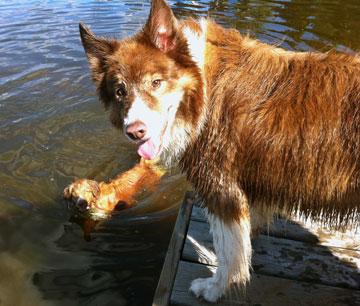Occasionally I see a post on one of the Facebook dog groups I am in that somebody is having an issue with their dog. They think their dog is having a stroke, or a seizure. Or it is just a small thing like getting off-balance. Depending on the severity of the issue, the dog’s eyes may be twitiching back and forth and the dog falling over, can barely walk – to just a slight head tilt. I’ve had experience with Canine Vestibular Syndrome a couple times so I wanted to share my story and hope that it helps others in the future!
I had noticed my 13-year-old Border Collie, Mocca, was starting to LEAN a bit when she was retrieving a ball. I thought it was a bit odd, and kept a closer eye on her. Generally, I am fairly in tune with her, so any small change in her behavior raises a red flag for me. Then I noticed her stumble a bit. I got concerned, and tried a few more retrieves, watching her steadily LEAN to the left as she trotted back. I brought her inside, to tell my boyfriend and see what he thought. After awhile, he too noticed her trip a few times, and start to tilt. Anxiety crept up more and more. I started to panic. What was going on? Was she having a stroke? Was there some sort of tumor? Was she having some sort of reaction to eating something? Was it a reaction from medication she was on for Lyme disease?
I started googling like mad, and soon was a bit soothed. I ruled out side effects from her medication, especially because she had been on it in the past. I ruled out stroke, as apparently, actual, legitimate strokes are very rare in dogs. She seemed to FEEL FINE, wasn’t sick at all, and really was quite perky. So, what I settled on was one of two things:
- An Inner Ear infection
- Canine Vestibular Syndrome, also known as Old Dog Disease

Also, I was familiar with Canine Vestibular Syndrome, as my parent’s older Golden Retriever, Annie, had a couple bouts of it in her later years. This seemed the most likely cause, as I did notice Mocca’s eyes darting back & forth, back & forth… Not normal. As time progressed, she got worse. By the next morning, she had a hard time standing. This was so terribly difficult to endure for both her and me – we would get to the vet ASAP in the morning as it was the weekend and after hours! It is so hard to see your dog in trouble like this and not be able to do anything. My research showed that likely there was nothing to do but wait it out.
I would add – that I did not go to the ER with her because I was experienced with this before, and as she was eating, drinking, pooping & peeing fine – I felt OK waiting even though it was difficult. I do not recommend not getting vet attention ASAP if you feel it is necessary.
Sunday I kept her subdued in her room, or outside in a crate so she could enjoy the beautiful day. I had to hold her up with a harness to go potty all day, and brought the water bowl to her and hand fed her. She was acting perfectly healthy except for her balance problems.
Monday morning arrived and she had not gotten any WORSE. YAY! We were off to the vet that afternoon, and after checking Mocca over, our veterinarian diagnosed like we expected – Canine Vestibular Syndrome. We did get her the antibiotic Clavamox, just in case there was an inner ear infection (her ears looked ok upon inspection). Sometimes vets will give Prednisone to dogs with this problem, but because Mocca is elderly, and her blood work 2 weeks ago had shown slightly elevated Liver Enzymes, we didn’t want to risk any further Liver issues.
Residual head tilt remained only. So, we waited it out. We got used to her balance problems, hand fed her and made sure she had water nearby at all times. We also kept her subdued, so that she couldn’t hurt herself falling. She was escorted outside on a harness to potty and walk around, and not allowed up or down any stairs. Little by little she improved!
A handful of days later, she was doing 85% better! Up and down stairs (though with my hand on her, I think it made her feel safer) – jumping up on the bed, racing outside to play, eating her food on her own, and barking at the kitten who got too close! Her head tilt remained, but did mostly go away after we visited a Pet Chiropractor a few times.
In researching Canine Vestibular Syndrome, I found a lot of stories of dogs MUCH worse than Mocca, whose owners had no idea what was going on and thought their dogs were dying. Some dogs have it much worse, so worse that they can barely stand up, and instead circle, salivate, vomit and altogether can’t function. If your dog is as bad off as that, vet assistance would be a priority so they don’t get dehydrated and have organ failure from there. Mocca was eating, drinking, and not sick at all, so we opted to wait to see our vet on Monday, but I would never have waited if she were sick at all.
Hopefully, this post helps out a few pet owners out there who may also experience this.






 We still have our issues: dog reactivity, leash reactivity, general crazy sometimes. But I know how to work through them, and with the help of the Prozac, Emme is able to calm down quicker and redirect to me and yummy treats. If we see you on the street with your dog, don’t be offended when we spin around and go the other way without any word – I just can’t take my focus off her and redirecting her. We try to avoid situations where she may feel threatened or confused, we avoid putting her into a position to guard me (she loves me so much, lucky me). Without the Prozac I’m not sure any of this could have occurred.
We still have our issues: dog reactivity, leash reactivity, general crazy sometimes. But I know how to work through them, and with the help of the Prozac, Emme is able to calm down quicker and redirect to me and yummy treats. If we see you on the street with your dog, don’t be offended when we spin around and go the other way without any word – I just can’t take my focus off her and redirecting her. We try to avoid situations where she may feel threatened or confused, we avoid putting her into a position to guard me (she loves me so much, lucky me). Without the Prozac I’m not sure any of this could have occurred.